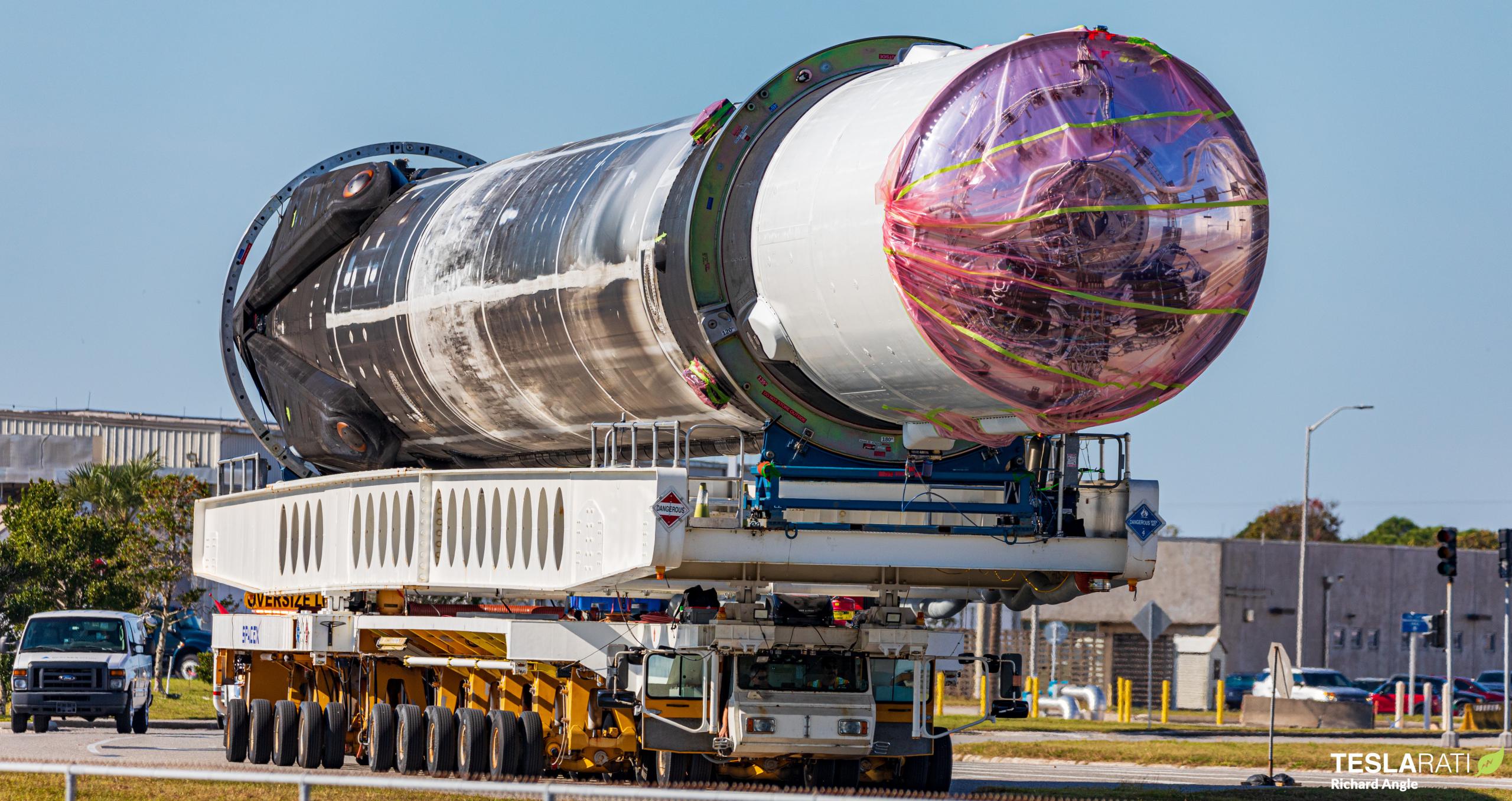
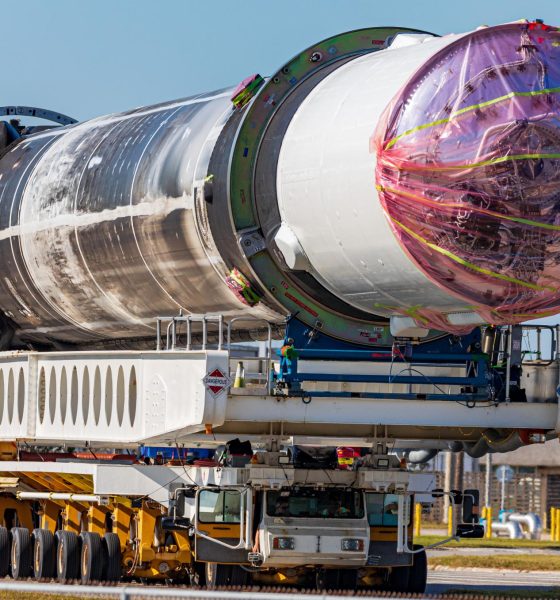
News
SpaceX converts Falcon Heavy booster into Falcon 9
More than two years after the rocket’s last launch, SpaceX appears to have finally decided to give at least one of two surviving Falcon Heavy Block 5 cores a new lease on life as a Falcon 9 booster.
Known as B1052, the Falcon Heavy side core or booster debuted in April 2019 as part of the first flight of the rocket’s Block 5 variant, successfully launching Saudi Arabia’s large Arabsat 6A communications satellite to an almost 90,000 km (56,000 mi) transfer orbit. Following in the footsteps of the first Falcon Heavy, the first Block 5 vehicle repeated its predecessor’s iconic double-landing back at Cape Canaveral. Just 74 days later, both Falcon Heavy Block 5 side boosters B1052 and B1053 launched again, this time supporting the US military’s long-delayed STP-2 rideshare and qualification mission.

Once again, B1052 and B1053 stuck near-simultaneous landings at SpaceX’s Landing Zones. Both missions’ center cores, however, weren’t so lucky. During Arabsat 6A, the first Falcon Heavy Block 5 center core did successfully land but high seas eventually toppled the booster, destroying it and leaving few intact remains. During STP-2, CEO Elon Musk revealed that SpaceX didn’t actually expect to recover the mission’s replacement center core due to the exceptionally hot reentry it would need to survive. As predicted, the center core did not survive, with Musk later reporting that the hot reentry damaged thrust vectoring hardware, causing the rocket to veer off course.
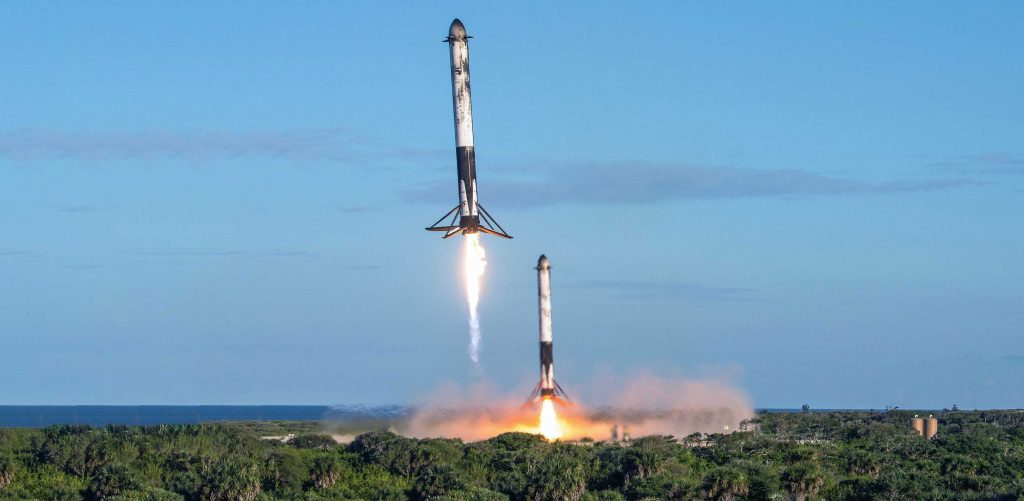
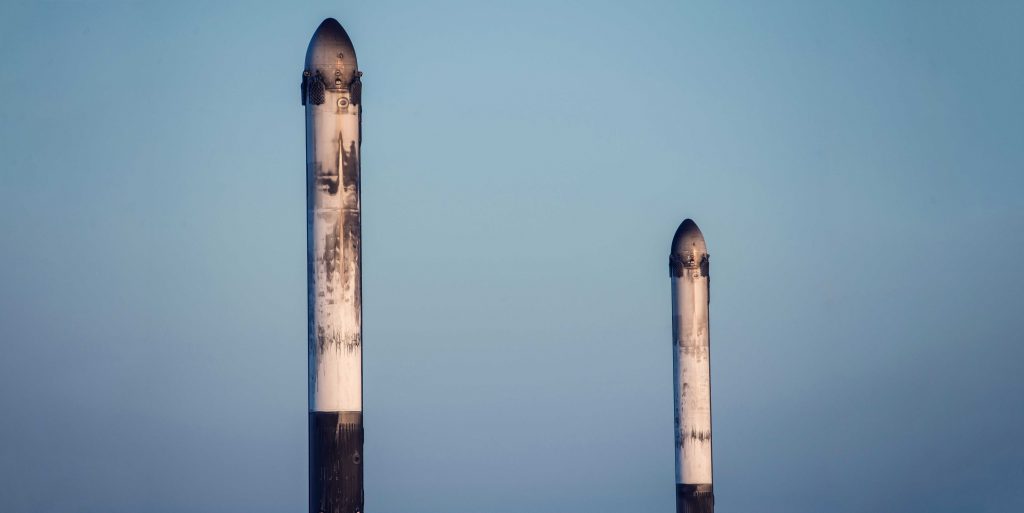
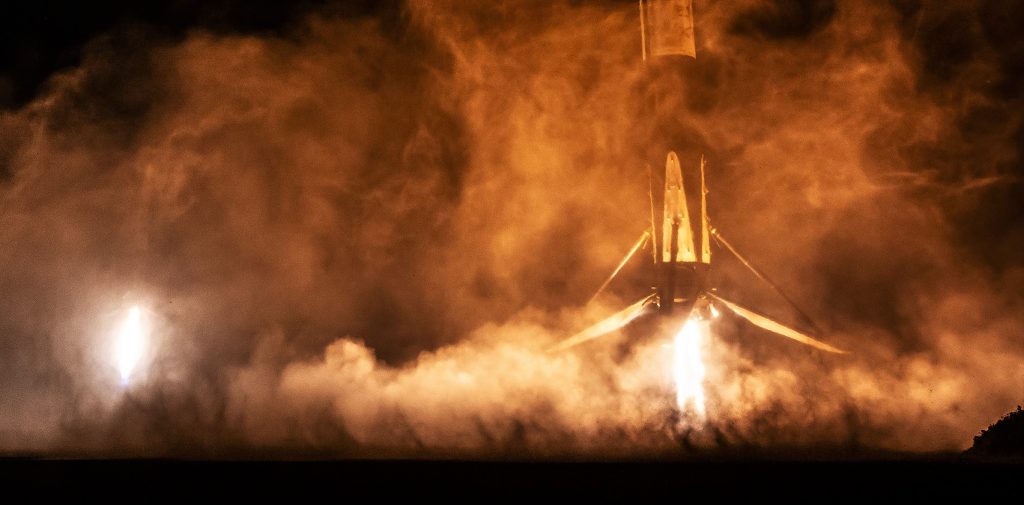
Thankfully, both side boosters aced all four of their collective landings. However, despite previous statements from Musk indicating that Falcon’s new Block 5 design made it fairly easy to convert Falcon first stages between Falcon 9 and Falcon Heavy side booster configurations, both B1052 and B1053 dropped off the face of the Earth immediately after completing STP-2. Only in September 2021, 27 months later, did one of the two cores finally reappear in public – sans landing legs and grid fins but with a nosecone still installed.
As is now clear, that surprise appearance after years in storage was no coincidence. A bit less than three months later after the mystery Falcon Heavy side booster was spotted rolling down a Kennedy Space Center highway from a Cape Canaveral storage hangar to a new SpaceX facility, one of the two side boosters (B1052) was spotted once again – this time with landing legs and a Falcon 9 interstage installed where a nosecone once sat.
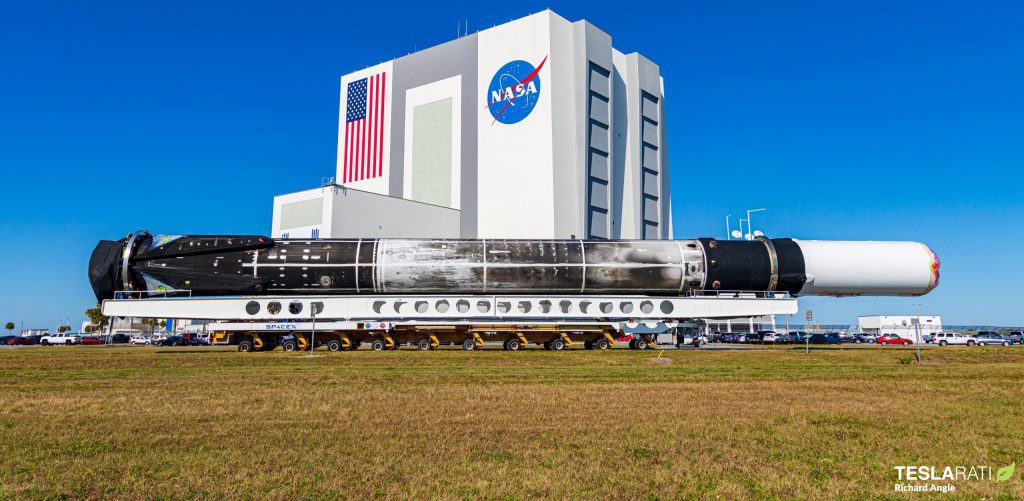
Aside from having clearly been converted into a Falcon 9 booster, former Falcon Heavy side booster B1052 was also mated to a new expendable upper stage – a strong indication of an imminent launch. Word on the ground is that the rocket and transporter were on their way to SpaceX’s Cape Canaveral Space Force Station (CCSFS) LC-40 pad for the company’s planned December 18th launch of Turkey’s Turksat 5B communications satellite.
Following SpaceX’s successful NASA IXPE launch on December 9th, the company has two more East Coast launches planned before the end of the year: Turksat 5B NET December 18th and CRS-24 NET December 21st. Several other Falcon 9 boosters (save for B1062, which is probably assigned to CRS-24) are likely available to launch Turksat 5B, so B1052’s assignment – while not implausible – isn’t guaranteed.
Above all else, B1052’s second life as a Falcon 9 is exciting because it means that B1053 probably isn’t far behind it, meaning that SpaceX’s fleet of operational Falcon boosters is about to grow significantly in a short period of time. As of now, that fleet contains eight Falcon 9 boosters that have each completed an average of more than six orbital-class launches. Half have flown nine times. Aside from expanding that fleet by 25%, the reintroduction of B1052 and B1053 will free up SpaceX to retire older boosters like B1049 and B1051, which CEO Elon Musk has said are slower and more expensive to reuse.

News
Tesla Cybercab tests are going on overdrive with production-ready units
Tesla is ramping its real-world tests of the Cybercab, with multiple sightings of the vehicle being reported across social media this week.

Tesla is ramping its real-world tests of the Cybercab, with multiple sightings of the autonomous two-seater being reported across social media this week. Based on videos of the vehicle that have been shared online, it appears that Cybercab tests are underway across multiple states.
Recent Cybercab sightings
Reports of Cybercab tests have ramped this week, with a vehicle that looked like a production-ready prototype being spotted at Apple’s Visitor Center in California. The vehicle in this sighting was interesting as it was equipped with a steering wheel. The vehicle also featured some changes to the design of its brake lights.
The Cybercab was also filmed testing at the Fremont factory’s test track, which also seemed to involve a vehicle that looked production-ready. This also seemed to be the case for a Cybercab that was spotted in Austin, Texas, which happened to be undergoing real-world tests. Overall, these sightings suggest that Cybercab testing is fully underway, and the vehicle is really moving towards production.
Production design all but finalized?
Recently, a near-production-ready Cybercab was showcased at Tesla’s Santana Row showroom in San Jose. The vehicle was equipped with frameless windows, dual windshield wipers, powered butterfly door struts, an extended front splitter, an updated lightbar, new wheel covers, and a license plate bracket. Interior updates include redesigned dash/door panels, refined seats with center cupholders, updated carpet, and what appeared to be improved legroom.
There seems to be a pretty good chance that the Cybercab’s design has been all but finalized, at least considering Elon Musk’s comments at the 2025 Annual Shareholder Meeting. During the event, Musk confirmed that the vehicle will enter production around April 2026, and its production targets will be quite ambitious.
News
Tesla gets a win in Sweden as union withdraws potentially “illegal” blockade
As per recent reports, the Vision union’s planned anti-Tesla action might have been illegal.

Swedish union Vision has withdrawn its sympathy blockade against Tesla’s planned service center and showroom in Kalmar. As per recent reports, the Vision union’s planned anti-Tesla action might have been illegal.
Vision’s decision to pull the blockade
Vision announced the blockade in early December, stating that it was targeting the administrative handling of Tesla’s facility permits in Kalmar municipality. The sympathy measure was expected to start Monday, but was formally withdrawn via documents sent to the Mediation Institute and Kalmar Municipality last week.
As noted in a Daggers Arbete report, plans for the strike were ultimately pulled after employer group SKR highlighted potential illegality under the Public Employment Act. Vision stressed its continued backing for the Swedish labor model, though Deputy negotiation manager Oskar Pettersson explained that the Vision union and IF Metall made the decision to cancel the planned strike together.
“We will not continue to challenge the regulations,” Petterson said. “The objection was of a technical nature. We made the assessment together with IF Metall that we were not in a position to challenge the legal assessment of whether we could take this particular action against Tesla. Therefore, we chose to revoke the notice itself.”
The SKR’s warning
Petterson also stated that SKR’s technical objection to the Vision union’s planned anti-Tesla strike framed the protest as an unauthorized act. “It was a legal assessment of the situation. Both for us and for IF Metall, it is important to be clear that we stand for the Swedish model. But we should not continue to challenge the regulations and risk getting judgments that lead nowhere in the application of the regulations,” he said.
Vision ultimately canceled its planned blockade against Tesla on December 9. With Vision’s withdrawal, few obstacles remain for Tesla’s long-planned Kalmar site. A foreign electrical firm completed work this fall, and Tesla’s Careers page currently lists a full-time service manager position based there, signaling an imminent opening.
News
Tesla Semi program Director teases major improvements
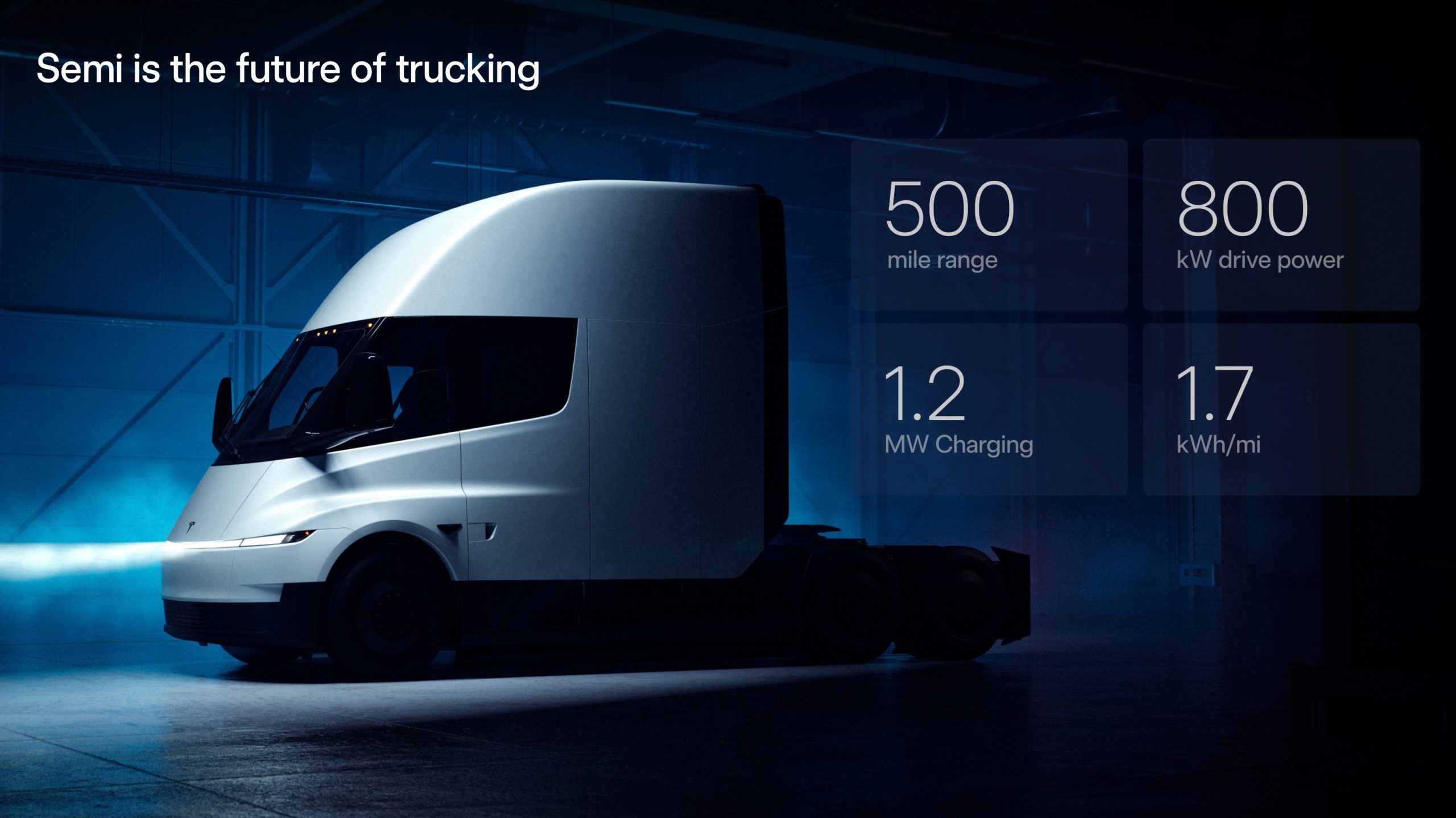
Tesla Semi Program Director Dan Priestly teased the major improvements to the all-electric Class 8 truck on Thursday night, following the company’s decision to overhaul the design earlier this year.
Priestley said he drove the Semi on Thursday, and the improvements appear to be welcomed by one of the minds behind the project. “Our customers are going to love it,” he concluded.
Just drove the redesigned Semi. Our customers are going to love it. https://t.co/KZ88sf1CDL
— Dan Priestley (@danWpriestley) December 19, 2025
The small detail does not seem like much, but it is coming from someone who has been involved in the development of the truck from A to Z. Priestley has been involved in the Semi program since November 2015 and has slowly worked his way through the ranks, and currently stands as the Director of the program.
Tesla Semi undergoes major redesign as dedicated factory preps for deliveries
Tesla made some major changes to the Semi design as it announced at the 2025 Annual Shareholder Meeting that it changed the look and design to welcome improvements in efficiency.
Initially, Tesla adopted the blade-like light bar for the Semi, similar to the one that is present on the Model Y Premium and the Cybertruck.
Additionally, there are some slight aesthetic changes to help with efficiency, including a redesigned bumper with improved aero channels, a smaller wraparound windshield, and a smoother roofline for better aero performance.
All of these changes came as the company’s Semi Factory, which is located on Gigafactory Nevada’s property, was finishing up construction in preparation for initial production phases, as Tesla is planning to ramp up manufacturing next year. CEO Elon Musk has said the Semi has attracted “ridiculous demand.”
The Semi has already gathered many large companies that have signed up to buy units, including Frito-Lay and PepsiCo., which have been helping Tesla test the vehicle in a pilot program to test range, efficiency, and other important metrics that will be a major selling point.
Tesla will be the Semi’s first user, though, and the truck will help solve some of the company’s logistics needs in the coming years.








